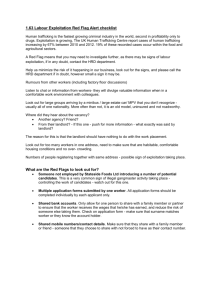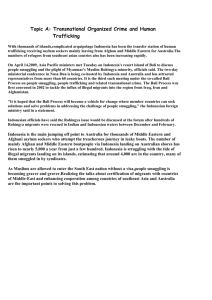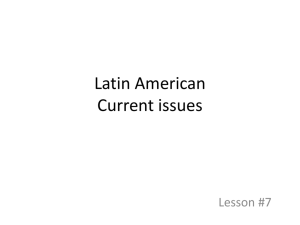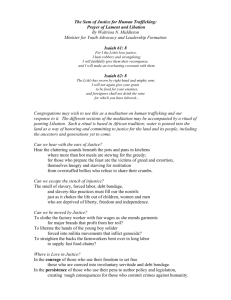Trafficking in Human Beings & Smuggling of Migrants
advertisement
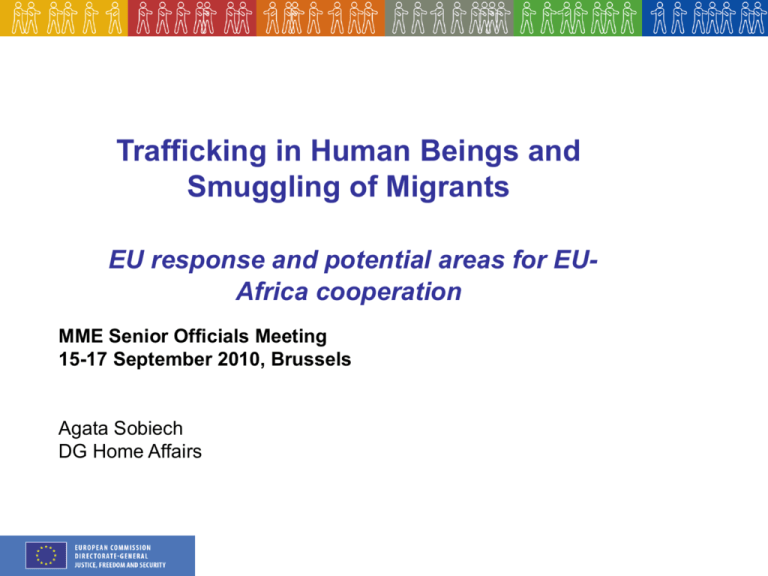
Trafficking in Human Beings and Smuggling of Migrants EU response and potential areas for EUAfrica cooperation MME Senior Officials Meeting 15-17 September 2010, Brussels Agata Sobiech DG Home Affairs Trafficking to/in the EU for: • • • • • • • Sexual exploitation Labour exploitation Organ removal Begging Street crime Terrorism ? …? Trafficking in the EU • The EU has among its 27 MS both transit and source countries (in particular among the new Member States) but is as a whole primarily a destination region. However, data for the EU are scattered and often based on estimations and extrapolations • IOM has estimated that about 120,000 women and children are trafficked every year through the Balkans alone. • ILO has estimated that, at minimum, 270,000 victims are under exploitation as a result of trafficking in the industrialized countries (Europe and North America), at any moment. • Transcrime has estimated that, in Italy alone, about 40,000 victims are exploited for sexual exploitation. Trafficking in the EU – Trends in Prosecution • The response to human trafficking in terms of number of convictions recorded per year is still weak, especially compared to the number of victims. • Most European countries record national conviction rates for human trafficking below one convict per 100,000 people. • In Europe, there are more convictions for rare crimes such as kidnapping in Denmark (3 per 100,000 people), homicide in Finland (4 per 100,000 people) or robbery in Norway (5.8 per 100,000 people) than for human trafficking (Source : UN. GIFT 2009) New EU Legal Framework • A new proposal for a Directive was adopted on 29 March 2010 – key principles : • Reinforcing a holistic approach (prevention, protection, prosecution) • Approximating substantive criminal law • Bringing robust provisions on victim's protection • Supporting the principle of non-punishment for petty crimes and unconditional assistance. Other Policy Initiatives • EU Anti-Trafficking Coordinator • EU Anti-Trafficking day • National Rapporteurs • THB Website • Partnership approach Partnership with non-EU countries • Introducing a fourth “P” – Partnership approach with third countries of origin and transit • Framework for action : the Action Oriented Paper on the external aspects of THB adopted in November 2009. • The aim of this AOP is to strengthen the commitment and co-coordinated action of the EU and the Member States to prevent and fight all forms of THB in partnership with third countries, regions and organisations at international level. EU Legal Framework on Smuggling of Migrants • Directive 2002/90/EC of 28 November 2002 defining the facilitation of unauthorised entry, transit, and residence: provisions relating to a definition of the general infringement, optional humanitarian clause and the obligation to establish proportionate, effective and dissuasive sanctions. • Framework Decision 2002/946/JHA of 28 November 2002 on the strengthening of the penal framework to prevent the facilitation of unauthorised entry, transit and residence: provisions relating to sanctions to be established, aggravating circumstances, penalties for natural and legal persons, jurisdiction, rules on extradition and prosecution. • Stockholm Programme Action Plan: the Commission will examine the possibility of strengthening EU instruments aimed at fight against smuggling of migrants and creating a single and coherent instrument. Supporting THB and Anti-Smuggling initiatives in nonEU countries • In addition to country and regional cooperation through the geographic instruments, the fight against trafficking is a priority in the thematic instruments, such as the AENEAS Programme (2004-2006) and currently, the Thematic Programme on Migration and Asylum and the Instrument for Democracy and Human Rights (EIDHR) • Countries benefiting from support: South Africa, Zambia, Nigeria, Benin, Zimbabwe, Gabon, Morocco, Senegal Examples of initiatives supporting African States at regional level - 3M global project implemented by UNODC to promote the ratification of the Smuggling and the Trafficking Protocols and their transposition into domestic law, provide capacity building for criminal justice actors to implement these protocols, improve assistance and protection to trafficking victims and smuggled migrants, and raise awareness among the public and vulnerable groups. - Strengthening the Criminal Justice System Response to Smuggling of Migrants in North Africa by establishing adequate legislative framework, building the capacities of law enforcement, prosecution and judiciary, strengthening international and regional cooperation and fostering awareness among relevant authorities and the general public (implemented by UNODC and Europol) - Law Enforcement Capacity Building Project for West Africa in Preventing and Combating the Smuggling of Migrants – building capacities and strengthening cooperation mechanisms among law enforcement and prosecution authorities to effectively prevent, investigate and prosecute smuggling of migrants, and to develop effective cooperation mechanisms with third countries to that end, while protecting rights of smuggled migrants (implemented by UNODC and Europol) Potential areas of enhanced cooperation at the regional and continental level • Continuing to promote ratification of the Smuggling and the Trafficking Protocols and their transposition into domestic law • Promoting dialogue and cooperation between countries within a region and along trafficking and smuggling routes The cooperation could focus in particular on: - prevention and awareness raising campaigns, including involvement of civil society - establishment and promotion of transnational referral mechanisms - prosecution of cross-border crimes - collection, dissemination and exchange of data - return and reintegration to avoid re-victimisation and ensure social inclusion • Distinction between actions addressing trafficking in human beings and smuggling of migrants? Thank You !


